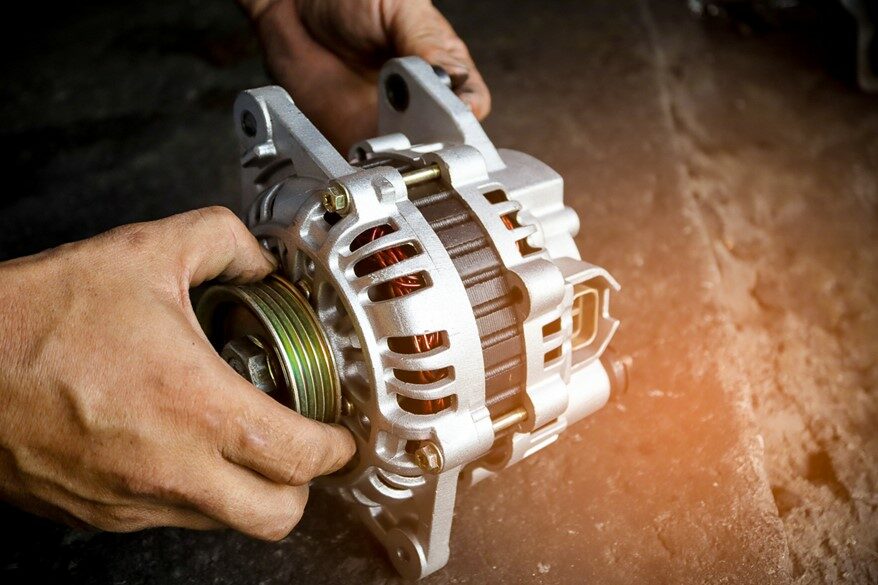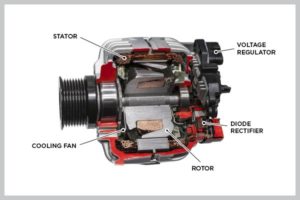
You may think your car battery is powering all things electrical in your car, be it your windshield wipers, headlights or radio. In reality, it’s the car alternator that produces the majority of your vehicle’s electricity — your battery is mainly just used to start your vehicle and provide power when the engine isn’t running.[1] The alternator is a critical component of a car’s charging system, so it’s helpful to understand how it operates in case you have to deal with your car not starting.
What is an alternator?
The alternator is a generator whose purpose is to distribute electricity to the car and recharge the battery. [1] Outside of some hybrid models, all vehicles with a standard internal combustion engine will have an alternator. About the size of a coconut, the alternator is generally mounted to the front of the engine and has a belt running around it. [2]
Parts of an alternator

The components of an alternator are geared toward providing the right type and right amount of power to the vehicle. Your car’s charging system contains many parts, but these are the main components and their functions:
Rotor and stator
The rotor and stator are the electricity-producing components of an alternator. The rotor, a cylindrical piece surrounded by magnets, spins inside of the stator, which holds a fixed set of conductive copper wiring. The movement of the magnets over the wiring is what ultimately creates electricity. [3]
The stator is attached to the alternator’s shell and does not move. It consists of the outer frame, stator core and stator winding. The stator, unlike the rotor, is highly insulated due to the high voltage that it creates. [4]
Voltage regulator
The voltage regulator oversees the power the alternator makes. [2] It monitors the level of voltage that is output to the battery and delivers power to the rest of the vehicle.
Diode rectifier
The diode rectifier converts the voltage from the alternator into a form that can be used by the battery to recharge. [5]
Cooling fan
Alternators give off a lot of heat and need to be cooled to operate efficiently. While they’re built with vents and aluminum casing to better release heat, they’re also equipped with rotating fans for added cooling. [5] New alternator models have internal cooling fans, whereas older versions tend to have external fan blades.
What is the difference between an alternator and generator?
Both alternators and generators convert mechanical energy into electrical energy. Besides that, they are very different. The main difference is that the magnetic field rotates around a stationary armature in an alternator, whereas the armature rotates inside a stationary magnetic field in a generator. [6]
How does an alternator work?
As we know, the alternator provides your car with the bulk of its electricity and helps to recharge the battery. But to do all of that, the alternator must first turn mechanical energy into electricity.
How the alternator produces electrical energy
The process of producing electricity begins with the engine. For most modern vehicles, alternators are driven by the engine’s crankshaft via a serpentine belt, though older vehicles may have a separate pulley going from the crankshaft to the alternator. The drive belt’s movement spins the alternator’s rotor at a high speed within the stator. [2]
Electrical energy is made as the rotor spins. The magnets surrounding the rotor are deliberately placed so that as they pass over the copper wiring in the stator, a magnetic field is created. [7] This magnetic field, in turn, produces voltage that is captured by the stator. This power then reaches the voltage regulator, which disperses electricity to the vehicle and manages the amount of voltage the battery receives. [2]
How does the alternator charge the car battery?
Before the battery can use the power coming from the alternator, it needs to be converted to a format that the battery can use. That’s because electricity can flow in different currents, or directions. Car batteries operate on one-way direct current (DC) electricity, while alternators output alternating current (AC) electricity, which occasionally flows in reverse. [8] So prior to going to the voltage regulator, power intended for the battery goes through a diode rectifier to turn into DC. [2] After the conversion, the battery can use the power to recharge.
Like any car part, your alternator can start to decline with time and might need to be replaced. Learn how to replace a bad alternator and what to do if your car breaks down on the road.
Sources:
[1] “What Are the Functions of an Alternator?” David McGuffin, itstillruns.com/functions-alternator-6148787.html (accessed May 4, 2023).
[2] “How Alternators Work,” Josh Briggs and Kristen Hall-Geisler auto.howstuffworks.com/alternator.htm (Aug. 3, 2022).
[3] “AC Motor – Basic Properties, Terminology and Theory,” galco.com/comp/prod/moto-ac.htm (accessed May 4, 2023).
[4] “Bermantec Alternator Parts Delivery Program,” bermantec.com/parts-of-the-alternator (accessed May 4, 2023).
[5] “Understanding the Alternator,” Kevin R. Sullivan, autoshop101.com/forms/alt_bwoh.pdf (accessed May 4, 2023).
[6] “Difference Between Alternator and Generator with Comparison,” electricaltechnology.org/2020/05/difference-between-alternator-generator.html (accessed May 4, 2023).
[7] “Alternators & Batteries | How They Work,” Donut Media, youtube.com/watch?v=nuLl_Z9_T9E (May 30, 2018).
[8] “What is the alternator and how does it work?” Bob Weber, chicagotribune.com/autos/sc-alternator-autos-0128-20160127-story.html (Feb. 6, 2016).
Disclaimer:
The information included here is designed for informational purposes only. It is not legal, tax, financial or any other sort of advice, nor is it a substitute for such advice. The information may not apply to your specific situation. We have tried to make sure the information is accurate, but it could be outdated or even inaccurate in parts. It is the reader’s responsibility to comply with any applicable local, state or federal regulations. Nationwide Mutual Insurance Company, its affiliates and their employees make no warranties about the information or guarantee of results, and they assume no liability in connection with the information provided. Nationwide and the Nationwide N and Eagle are service marks of Nationwide Mutual Insurance Company. ©️ 2023 Nationwide



